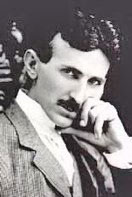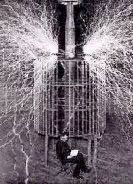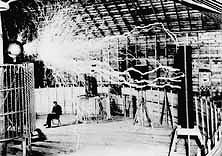|
Issue No.11
November/December 1998 ISSN 1326-8414
When asked who he felt was the world’s greatest inventor, science editor and publisher, Hugo Gernsback, said,
Nikola Tesla was born at midnight on July 9, 1856 in Smiljan, Lika, Croatia. He was known to say, "I am a Serb but my fatherland is Croatia." At the age of twenty-six while walking with a friend in a park in Budapest, Nikola recalled,
He was talking about an alternating current (AC) induction motor. Nikola patented his motor in 1893 and used it to light the World Columbian Exposition in Chicago in the same year. Then in 1896 the world’s first hydroelectric power was sent from Niagara Falls to light the city of Buffalo. Nikola Tesla, through George Westinghouse, had laid the foundations of the power system used around the world today.
Many scientists and individuals acknowledge
Tesla’s foresightedness
and accredit him as being the originator of many of today’s
inventions. The wording to describe Tesla’s 1891 carbon button lamp
(the "brush"), with minimal word change, serves well as a
description of the million-magnification point electron microscope
developed by Vladimir R. Zworykin in 1939. The "brush" has also been
related to the cyclotron and the atom smasher.
Fifty years before the development of the fluorescent lamp, Nikola built phosphor-coated globes and illuminated his gas-filled tubes, which he had twisted into names. The disputed credit for the invention of the radio was settled in 1943 when the U.S. Supreme Court reversed an initial finding in Marconi’s favor to rule that Tesla had anticipated all other contenders with his fundamental radio patents.
The list of credits given to
Nikola Tesla is large indeed. He has
been associated with cosmic rays, radar, diathermy, the
high-frequency furnace, wave-guide for microwave transmission, space
navigation code, cryogenic engineering, electrotherapeutics, energy
transmission to satellites, principles of solid state transistor
technology, and the reciprocating dynamo.
The small Tesla Coil generates high voltages and
high frequencies and is used in one form or another in every radio
and television set and can be found in every university science
laboratory: used to detect leaks in vacuum apparatus.
Though his genius was often ridiculed, his own comments showed his confidence.
In his younger years Nikola sensed the universe was,
In his sunset years, Tesla believed that all matter came from a
primary substance, the luminiferous ether, which filled all space.
Amongst his many legacies to society are a
number of small items
that employ Nikola’s discoveries in both electricity and
vibration. Nikola influenced the production of
personal oscillators that
vibrate in tune with "the luminiferous ether" (collectively called,
Purple Plates). Like many of his inventions, the plates cannot be
explained, and yet for over twenty-eight years the plates have
continued to offer the same "increase comfort and happiness" to
society that his poly phase system has provided since 1896.
|


 Tesla’s genius with electricity received further stimulation through
his interest in resonance. The ubiquitous Tesla Coil is evidence of
the synergy of electricity and vibrations. With a power cord from an
insulated handle at one end and primary and secondary coils tuned to
resonate at the other end, the Tesla Coil, when plugged in, begins
to vibrate and hum.
Tesla’s genius with electricity received further stimulation through
his interest in resonance. The ubiquitous Tesla Coil is evidence of
the synergy of electricity and vibrations. With a power cord from an
insulated handle at one end and primary and secondary coils tuned to
resonate at the other end, the Tesla Coil, when plugged in, begins
to vibrate and hum.